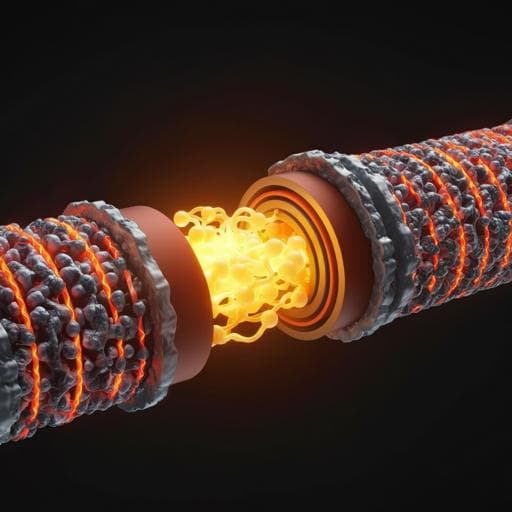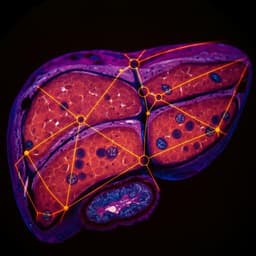
Engineering and Technology
Deep learning-based segmentation of lithium-ion battery microstructures enhanced by artificially generated electrodes
S. Müller, C. Sauter, et al.
Dive into groundbreaking research by Simon Müller, Christina Sauter, Ramesh Shunmugasundaram, Nils Wenzler, Vincent De Andrade, Francesco De Carlo, Ender Konukoglu, and Vanessa Wood that unveils a deep-learning approach for accurate 3D segmentation of lithium-ion battery electrodes, enhancing our understanding of battery performance like never before.
~3 min • Beginner • English
Introduction
The study addresses the challenge of accurately segmenting 3D microstructures of lithium-ion battery electrodes, especially graphite–silicon composite anodes, where low contrast between phases (graphite, pore, and carbon black–binder domain) and multiscale features hinder conventional segmentation. Accurate multiphase segmentation enables quantitative analysis of morphology that governs ionic/electronic transport, overpotentials, capacity, and mechanical stability. X-ray tomographic microscopy (XTM) offers non-destructive 3D imaging but suffers from insufficient contrast/resolution trade-offs for fully resolving all phases. Traditional thresholding and graph-based methods fail to reliably separate graphite from pore and to capture fine CBD features. The study proposes supervised deep learning (3D U-Net) for semantic segmentation of volumetric electrode images and investigates how to overcome limited, hard-to-acquire labeled training data by augmenting scarce multimodal (PXCT+XTM) real datasets with computationally generated synthetic datasets, aiming to achieve accurate, automated four-phase segmentation and to enable statistically meaningful microstructural analysis and its evolution with cycling.
Literature Review
Prior work shows that LIB performance depends on electrode morphology, with pore structure controlling effective ion transport and CBD distribution impacting electronic pathways and mechanics. X-ray tomography is widely used but limited by contrast and field-of-view; high-resolution nanoscale methods are time consuming and not representative. Conventional segmentation in battery imaging often relies on filtering plus thresholding; random walker/graph-based methods improve boundaries but still fail under low contrast and require manual seeding. Deep learning has been used in batteries for state estimation, design, and defect detection, but comprehensive 3D, multi-phase semantic segmentation of low-contrast anodes using architectures like 3D U-Net (popular in medical imaging) has not been established. Generating synthetic data to augment learning has proven effective in computer vision (e.g., face recognition, autonomous driving). CycleGAN-based style transfer can morph basic structures into realistic textures. The study leverages these advances to create hybrid training datasets (real multimodal PXCT+XTM labeled pairs plus synthetic structures with simulated tomography) to improve segmentation of challenging electrode datasets.
Methodology
- Samples and imaging: Graphite–silicon composite negative electrodes (75 wt% graphite, 10 wt% silicon (SiOx), 10 wt% PVDF, 5 wt% carbon black; 50 vol% of CB replaced by Cu nanoparticles for contrast) were prepared and assembled into Li half-cells. Electrodes were cycled at C/20 for 2, 5, or 8 cycles; pristine electrodes also analyzed. Cylindrical samples (<70 µm diameter) were laser-milled. Twelve samples in total (3 per cycling state) were imaged by XTM at APS 32-ID-C (8.4 keV, 1210 projections, 2 s exposure, voxel size 27.5 nm). Reconstruction used ASTRA Filtered Back Projection with Paganin phase retrieval (δ/β=0.028; β/β=0.28). Resolution was 119 nm by Fourier shell correlation.
- Real learning data: Two cylindrical volumes (40 µm diameter × 20 µm height) from pristine and cycled electrodes underwent multimodal PXCT+XTM imaging; combined data enabled accurate four-phase segmentation by thresholding, creating labeled output maps. XTM reconstructions served as input images; segmented multimodal volumes served as output labels. From these real datasets, 1000 random subvolume pairs of 256×256×48 voxels (15.6×15.6×3 µm) were sampled with augmentations (applied to 50%): Gaussian noise/blur, contrast/brightness variation, and affine transforms. Training used a 3D U-Net (implementation following Baumgartner et al.), trained for 100 epochs (~72 h on NVIDIA TITAN Xp).
- Synthetic learning data generation: Basic artificial electrode structures were generated in MATLAB defining particle volume fractions, size, shapes, and orientations for graphite, silicon, and CBD. To introduce realistic small-scale features, a CycleGAN style transfer was trained using real segmented structures as templates, producing realistic-looking segmented synthetic structures. Tomography simulations were performed with ASTRA to produce corresponding intensity images by assigning material refractive indices, generating 2D projections including realistic beamline effects (locally varying illumination and edge enhancement), and reconstructing as per real data. Each synthetic dataset provided input (simulated XTM) and output (labeled synthetic structure) pairs. In total, 21 artificial datasets (20 µm cubes) were created.
- Hybrid training: Models were retrained using hybrid learning data: 500 subvolume pairs from real datasets and 500 from artificial datasets. Training protocol otherwise identical.
- Post-processing and inference: For each of the 12 XTM datasets, reconstructions were binned to voxel size 61 nm. Cubic analysis volumes of 47 µm edge were extracted. Due to memory constraints, volumes were tiled into overlapping subvolumes of 48×256×256 voxels (and permuted orientations: x, y, z), with half-overlap, yielding 775 patches per direction. For each patch, softmax probability maps over four classes (pore, graphite, silicon, CBD) were computed, then fused across orientations to form final segmentation. To refine CBD vs pore, an automatic k-means-derived intensity threshold (graphite/silicon boundary in histogram) was applied to voxels predicted as CBD or pore: above threshold assigned to CBD (due to Cu staining), below to pore.
- Ground truth and metrics: A 400-slice subvolume from one pristine sample was manually segmented (Dragonfly) to serve as ground truth (not used in training). Segmentation quality was evaluated with 19 metrics; primary metric reported: Dice coefficient per phase.
- Microstructural analysis: Volume fractions per phase were quantified and compared to manufacturing targets (51% pore, 35% graphite, 6% silicon, 8% CBD). Surface coverage of graphite and silicon by pore vs CBD was computed. Location-specific analysis used concentric shells (61 nm width) around graphite and silicon phases, excluding overlaps and regions beyond 600 nm. Median pore radius was 360 nm; average CBD content in pore was ~17%. Diffusion simulations (GeoDict DiffuDict, finite-volume solver EJ) computed effective transport coefficient δ=D_eff/D in through-plane direction under symmetric Dirichlet boundary conditions; also porosity and tortuosity τ were calculated, both including CBD and neglecting CBD (treating CBD as pore).
Key Findings
- Segmentation performance (Dice coefficients, pristine sample, four classes):
• Training on real data only: Pore 0.63; Graphite 0.65; Silicon 0.69; CBD 0.38.
• Hybrid (real + artificial) data: Pore 0.69; Graphite 0.77; Silicon 0.82; CBD 0.58.
• Hybrid + thresholding (CBD/pore refinement): Pore 0.72; Graphite 0.77; Silicon 0.82; CBD 0.72.
Visual assessment confirmed improved separation of graphite from pore and better CBD detail with hybrid training.
- Volume fractions across 12 datasets matched manufacturing targets within variability: measured averages ~49% pore, 36% graphite, 7% silicon, 8% CBD vs targets 51/35/6/8%.
- Surface coverage: Graphite surfaces were ~97% in contact with pore and ~3% with CBD, essentially unchanged with cycling (pristine to 8 cycles). Silicon surfaces in pristine were ~53% pore, ~46% CBD; after 2 cycles at C/20, pore contact increased to ~65%, indicating CBD detachment from silicon surfaces; trends persisted for higher cycle counts.
- Effective transport and morphology (through-plane): Including CBD, δ ≈ 0.14 on average and remained approximately constant with cycling. Neglecting CBD increased δ to ≈ 0.19, showing CBD presence reduces effective transport by about 27% via both reduced porosity and increased tortuosity.
Table 2 (mean ± sd):
• Effective transport δ (including CBD): Pristine 0.1492±0.0369; 2 cycles 0.1277±0.0287; 5 cycles 0.1351±0.0292; 8 cycles 0.1435±0.0224. Neglecting CBD: 0.2098±0.0445; 0.1853±0.0316; 0.1810±0.0308; 0.2004±0.0307.
• Porosity ε% (including CBD): 50.52±7.57; 46.58±4.86; 47.52±4.67; 50.04±4.09. Neglecting CBD: 58.47±8.25; 54.58±4.46; 54.00±4.05; 57.88±4.62.
• Tortuosity τ (including CBD): 3.3465±0.3656; 3.6076±0.5970; 3.4711±0.4273; 3.4092±0.2334. Neglecting CBD: 2.7651±0.2209; 2.9287±0.4523; 2.9587±0.3465; 2.8558±0.2261.
- Location-specific CBD evolution:
• Around graphite: CBD content near surface matched ~3% surface coverage; cycling did not significantly change near-surface distribution within error; CBD tended to compress toward pore centers.
• Around silicon: CBD coverage near surface decreased from ~50% (pristine) to ~40% with cycling; CBD content exhibited a minimum at ~300 nm from silicon surface then increased, indicating detachment and repositioning of CBD into mid-pore regions; consistent with ~250 nm gap formation reported previously.
- Representativeness: Despite local changes near silicon, electrode-level metrics (e.g., δ, pore size distribution) showed no strong systematic trends with cycling, likely due to small silicon volume fraction (~6%) and sample-to-sample variability.
Discussion
The research question was whether deep learning can reliably segment low-contrast, multi-phase 3D electrode images and, if constrained by limited labeled data, whether synthetic data can enhance performance sufficiently to enable quantitative analysis. The findings show that augmenting scarce real multimodal training data with carefully generated synthetic datasets (basic structures stylized by CycleGAN and passed through realistic tomography simulation) substantially improves segmentation accuracy, especially for the challenging CBD and graphite/pore separation. The improved Dice scores (CBD from 0.38 to 0.72 with hybrid+thresholding) demonstrate that synthetic data can compensate for limited experimental training data and artifacts such as cut particles.
This segmentation capability enables statistically meaningful analyses across multiple small volumes, revealing that CBD morphology strongly influences effective ionic transport (reducing δ by ~27%) and that electrode-level effective transport remains relatively constant through early cycling, even while local CBD detachment and relocation occurs predominantly around silicon particles. These insights connect microstructural evolution to transport properties and interface coverage, informing design considerations for composite anodes (e.g., tailoring CBD adhesion near silicon, managing pore morphology). The approach illustrates how integrating domain knowledge (phase fractions, particle sizes) and imaging physics into synthetic data generation extends deep learning to complex materials systems beyond high-contrast cases.
Conclusion
This work introduces a hybrid-data deep learning framework for 3D semantic segmentation of lithium-ion battery electrodes, combining limited real PXCT+XTM labeled datasets with realistically generated synthetic training data (CycleGAN-based style transfer and tomography simulations). Using a 3D U-Net with hybrid training and a simple histogram-based refinement, the method achieves robust four-phase segmentation (pore, graphite, silicon, CBD) with Dice scores up to 0.72–0.82 and enables quantitative, statistically relevant microstructural analyses across multiple samples. Key insights include the dominant role of CBD in reducing effective ion transport (~27%), stability of electrode-level transport metrics over early cycling, and local CBD detachment and repositioning around silicon particles.
Future directions include expanding databases of real and synthetic training data for broader electrode chemistries and imaging conditions, improving models to directly infer higher-level features (e.g., CBD network connectivity, defects) without full segmentation, incorporating operando datasets to capture transient changes, and integrating measured or modeled CBD ionic/electronic transport properties to refine structure–property predictions.
Limitations
- Limited representativeness due to small fields of view and sample volumes; only twelve samples analyzed with subvolumes, leading to variability and potential sampling bias.
- Ex-situ analysis does not track the same region during cycling; conclusions reflect permanent changes, not transient dynamics.
- Imaging resolution (119 nm) cannot resolve nanoscale CBD internal porosity (~27±3%) or very fine features; graphite identification relies partly on edge enhancement, potentially underestimating CBD-graphite contact.
- Real training data were scarce (two multimodal volumes), potentially biasing the network; synthetic data mitigate but depend on assumptions about phase distributions and imaging simulation fidelity.
- Effective transport coefficients from numerical simulations may differ from electrochemical measurements (e.g., EIS) and can be affected by incomplete pore infilling and boundary conditions; values should be interpreted with caution given limited representativity.
Related Publications
Explore these studies to deepen your understanding of the subject.







